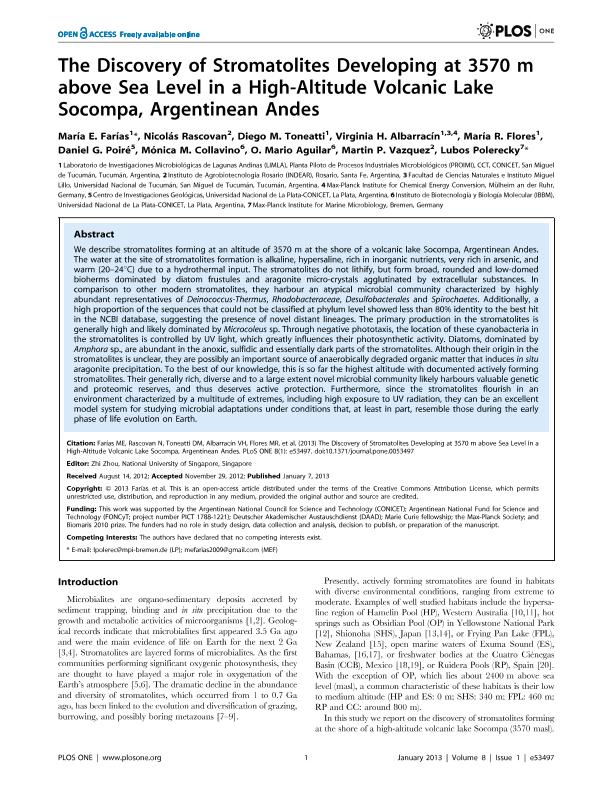Artículo
Discovery of Stromatolites Developing under Extreme Conditions in the Andeans Lakes.
Farías, María Eugenia; Rascovan, Nicolas ; Toneatti, Diego
; Toneatti, Diego ; Albarracín, Virginia Helena
; Albarracín, Virginia Helena ; Flores, María Regina
; Flores, María Regina ; Poire, Daniel Gustavo
; Poire, Daniel Gustavo ; Collavino, Mónica Mariana
; Collavino, Mónica Mariana ; Aguilar, Orlando Mario
; Aguilar, Orlando Mario ; Vazquez, Martin Pablo
; Vazquez, Martin Pablo ; Polerecky, Lubos
; Polerecky, Lubos
 ; Toneatti, Diego
; Toneatti, Diego ; Albarracín, Virginia Helena
; Albarracín, Virginia Helena ; Flores, María Regina
; Flores, María Regina ; Poire, Daniel Gustavo
; Poire, Daniel Gustavo ; Collavino, Mónica Mariana
; Collavino, Mónica Mariana ; Aguilar, Orlando Mario
; Aguilar, Orlando Mario ; Vazquez, Martin Pablo
; Vazquez, Martin Pablo ; Polerecky, Lubos
; Polerecky, Lubos
Fecha de publicación:
01/2013
Editorial:
Public Library of Science
Revista:
Plos One
ISSN:
1932-6203
Idioma:
Inglés
Tipo de recurso:
Artículo publicado
Clasificación temática:
Resumen
We describe stromatolites forming at an altitude of 3570 m at the shore of a volcanic lake Socompa, Argentinean Andes. The water at the site of stromatolites formation is alkaline, hypersaline, rich in inorganic nutrients, very rich in arsenic, and warm (20-24°C) due to a hydrothermal input. The stromatolites do not lithify, but form broad, rounded and low-domed bioherms dominated by diatom frustules and aragonite micro-crystals agglutinated by extracellular substances. In comparison to other modern stromatolites, they harbour an atypical microbial community characterized by highly abundant representatives of Deinococcus-Thermus, Rhodobacteraceae, Desulfobacterales and Spirochaetes. Additionally, a high proportion of the sequences that could not be classified at phylum level showed less than 80% identity to the best hit in the NCBI database, suggesting the presence of novel distant lineages. The primary production in the stromatolites is generally high and likely dominated by Microcoleus sp. Through negative phototaxis, the location of these cyanobacteria in the stromatolites is controlled by UV light, which greatly influences their photosynthetic activity. Diatoms, dominated by Amphora sp., are abundant in the anoxic, sulfidic and essentially dark parts of the stromatolites. Although their origin in the stromatolites is unclear, they are possibly an important source of anaerobically degraded organic matter that induces in situ aragonite precipitation. To the best of our knowledge, this is so far the highest altitude with documented actively forming stromatolites. Their generally rich, diverse and to a large extent novel microbial community likely harbours valuable genetic and proteomic reserves, and thus deserves active protection. Furthermore, since the stromatolites flourish in an environment characterized by a multitude of extremes, including high exposure to UV radiation, they can be an excellent model system for studying microbial adaptations under conditions that, at least in part, resemble those during the early phase of life evolution on Earth.
Palabras clave:
extreme environmets
,
high-altitud lakes
,
stromatolites
,
diversity
Archivos asociados
Licencia
Identificadores
Colecciones
Articulos(PROIMI)
Articulos de PLANTA PILOTO DE PROC.IND.MICROBIOLOGICOS (I)
Articulos de PLANTA PILOTO DE PROC.IND.MICROBIOLOGICOS (I)
Citación
Farías, María Eugenia; Rascovan, Nicolas; Toneatti, Diego; Albarracín, Virginia Helena; Flores, María Regina; et al.; Discovery of Stromatolites Developing under Extreme Conditions in the Andeans Lakes.; Public Library of Science; Plos One; 8; 1; 1-2013
Compartir
Altmétricas



